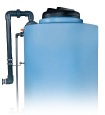Exploring Risks and Costs Associated with Chemical Storage Tank Failures
When a chemical storage tank fails, the costs can be significant to your organization. Regulatory concerns, environmental cleanup, property damage, and injury to employees can be costly exposures.
Let’s take a look at a few of the reasons chemical storage tanks fail.

Steel Storage Tanks
Steel is often seen as an ideal material for chemical storage tanks, because of its resistance to degradation. But tanks constructed from mild or stainless steel are subject to failure in two main areas.
- Steel chemical storage tanks are fabricated with sheets of metal, which are welded together to form the tank. Leaks can form at the weld seams, especially if the weld quality is poor.
- In addition, chemical attacks can break down the integrity of the metal itself. For example, sulfuric acid can become very aggressive if concentrations are below 93%, resulting in acid etching. Acid etching reduces the structural integrity of the stainless steel tank. The chemical concentrations can then become altered due to improper venting, increased humidity, or different concentrations from the supplier.
We recommend performing regular inspections on your steel chemical storage tank.
Fiberglass Storage Tanks
Fiberglass is a multi-layer composite construction with an outer layer of resin. Fiberglass reinforced plastic (FRP) tanks can be prone to micro cracks. Once the resin layer is compromised by micro cracking, it can impact and compromise the structural filament layer of the tank. Chemicals will tend to find the cracks and expand the damage.
Micro cracks in FRP tanks can lead to tank leaks, potential tank failure, and even catastrophic failure of the tank. It is very difficult to repair the entire compromised area when micro cracks develop in fiberglass reinforced plastic storage tanks.
We recommend performing regular inspections on your fiberglass chemical storage tank.
Polyethylene Chemical Storage Tanks
There are two primary types of polyethylene tank construction. Both create storage tanks that are free of welds or seams: linear (non-molecular bonded) and cross-linked (molecular bonded) polyethylene.
Linear Polyethylene Tanks
Linear poly storage tanks have the potential to come apart at the polymer chains. This is due to a lack of molecular bonding and a reliance on static attraction to gain strength. This is known as the van der Waals force. Be very cautious when selecting linear polyethylene material for chemical storage tanks, because it is designed to be a general purpose material. Linear polyethylene is used in many applications, from toys to containers.
When designing a linear polyethylene tank, it is very important to consider its susceptibility to crack propagation. Furthermore, installing a fitting creates an environment that can lead to cracks. Fitting areas need to be inspected for cracks on a regular basis. A linear poly tank under pressure, or even under static load, can experience a catastrophic failure, similar to what happens when dropping a gallon of milk that splits apart.
Cross-linked Polyethylene Tanks
Cross-linked polyethylene chemical storage tanks are covalently bonded, or molecularly bonded. They are extremely resistant to stress cracks, and are designed for chemical storage and greater useful life. Just like all chemical storage tanks, special attention must be paid to the mechanical fittings on a cross-linked poly chemical storage tank.
If stress occurs due to over pressurization or hard piping, spider or micro cracks can form. The advantage of cross-linked polyethylene is that in most cases it will not catastrophically fail. It may, however, require you to cut the compromised section out of the tank and install a larger fitting or replace the tank. While this may be more costly, the risk of large cracks and catastrophic failure of cross-linked polyethylene storage tanks is extremely low.
Storing chemicals safely and avoiding the expense of a chemical leak or catastrophic failure of a storage tank is always a concern. When it comes to greater useful life and peace of mind, cross-linked polyethylene is a great choice. Carefully consider the materials and construction of the storage tank and the chemicals that are being stored.
To explore the advantages of a durable high density cross-linked polyethylene chemical storage tank system for your facility, contact a Poly Processing storage system specialist.
- April 7, 2025
- Topics: Fittings and Accessories
About Poly Processing
Posts By Topic
Tech Talk Podcast Episodes
Subscribe By Email
Recent Posts
- Popular Customization Options for Chemical Storage Tanks
- Understanding Flood Zones Under the IBC: Building Requirements and Insurance Implications
- Choosing Between Steel, Polyethylene, and Fiberglass Tanks: What You Need to Know
- Getting Your Plastic Tank Foundation Right: Why Professional Design Matters
- What to Expect in Lead Times for Chemical Storage Tanks: Planning Ahead
Tank Configurator

Find the recommended tank and system components for your chemical storage challenge.
Configure a Tank Package





